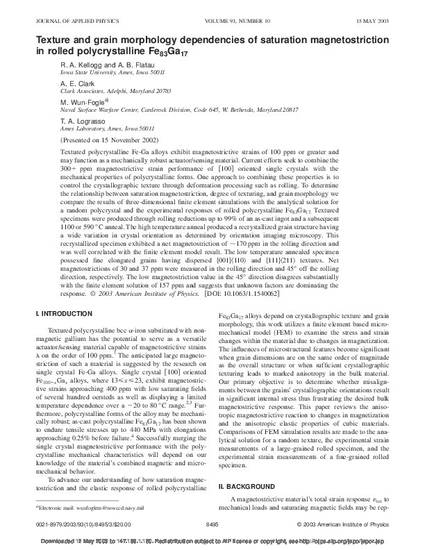
Presentation
Texture and grain morphology dependencies of saturation magnetostriction in rolled polycrystalline Fe83Ga17
Ames Laboratory Conference Papers, Posters, and Presentations
Document Type
Conference Proceeding
Disciplines
Conference
47th Annual Conference on Magnetism and Magnetic Materials
Publication Date
5-15-2013
DOI
10.1063/1.1540062
Geolocation
(27.950575, -82.45717760000002)
Abstract
Textured polycrystalline Fe-Ga alloys exhibit magnetostrictive strains of 100 ppm or greater and may function as a mechanically robust actuator/sensing material. Current efforts seek to combine the 300+ ppm magnetostrictive strain performance of [100] oriented single crystals with the mechanical properties of polycrystalline forms. One approach to combining these properties is to control the crystallographic texture through deformation processing such as rolling. To determine the relationship between saturation magnetostriction, degree of texturing, and grain morphology we compare the results of three-dimensional finite element simulations with the analytical solution for a random polycrystal and the experimental responses of rolled polycrystalline Fe83Ga17.Textured specimens were produced through rolling reductions up to 99% of an as-cast ingot and a subsequent 1100 or 590 °C anneal. The high temperature anneal produced a recrystallized grain structure having a wide variation in crystal orientation as determined by orientation imaging microscopy. This recrystallized specimen exhibited a net magnetostriction of ∼170 ppm in the rolling direction and was well correlated with the finite element model result. The low temperature annealed specimen possessed fine elongated grains having dispersed {001}〈110〉 and {111}〈211〉 textures. Net magnetostrictions of 30 and 37 ppm were measured in the rolling direction and 45° off the rolling direction, respectively. The low magnetostriction value in the 45° direction disagrees substantially with the finite element solution of 157 ppm and suggests that unknown factors are dominating the response.
Copyright Owner
American Institute of Physics
Copyright Date
2003
Language
en
Citation Information
R. A. Kellogg, A. B. Flatau, A. E. Clark, M. Wun-Fogle, et al.. "Texture and grain morphology dependencies of saturation magnetostriction in rolled polycrystalline Fe83Ga17" Tampa, FL(2013) Available at: http://works.bepress.com/thomas_lograsso/159/

Copyright 2003 American Institute of Physics. This article may be downloaded for personal use only. Any other use requires prior permission of the author and the American Institute of Physics.
The following article appeared in Journal of Applied Physics 93 (2013): 8495 and may be found at http://dx.doi.org/10.1063/1.1540062.